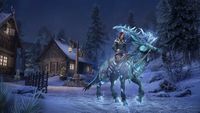Lore:Solstice
Solstice is an astronomical event that happens twice a year when the sun reaches its highest or lowest point in the sky at noon.[1][2]
Winter Solstice[edit]
The winter solstice is the shortest day of the year, when the sun is at its lowest point in the sky. A number of beliefs and practices are linked to the Winter Solstice. The New Life Festival,[3][4] observed on the 1st of Morning Star,[5] celebrates the end of the old year and the start of the new, symbolizing hope and fresh beginnings. It also marks the Winter Solstice, when Magnus the Sun begins his return and the days start to lengthen. Each Tamrielic culture has its own traditions related to this event.[3][UOL 1]
One legend surrounding the birth of Solstice Indriks claims that it originated from a child's toy, magically transformed on the year's longest night. However, other conflicting beliefs and stories also surround its mysterious birth.[2]
Alduin, the Twilight God who ushers in the next cycle,[6] was once venerated during the Winter Solstice through ceremonies held at ancient Dragon Cult temples. Offerings were made to keep him asleep for another year.[UOL 2] Certain practices and rituals, meant to ensure his prolonged slumber, persisted long after the fall of the Dragon Cult, continuing into the Interregnum of the Second Era.[6]
Some pieces of equipment were named after the winter solstice. In the late days of the Third Era, the Shield of Winter Solstice, an elven shield imbued with resistance to frost, was found in Cyrodiil.[7]
Summer Solstice[edit]
The summer solstice is the longest day of the year, when the sun is at its highest point in the sky. The exact date of the summer solstice in the Tamrielic calendar is unclear. During this time, Masser shines brightly in the sky,[1] and the constellation of the Steed becomes prominent in the southern sky.[8] The Khajiiti clergy of Alkosh in Sunspire compare Jode to the intense heat and redness of the summer solstice.[9]
Notes[edit]
- Aghaedh of the Solstice was a powerful spriggan who resided in the Marsh of Sacrifices, within the Hunting Grounds, the realm of the Daedric Prince Hircine. Its spriggan saplings were believed to symbolize the passage of the seasons.[10][11]
References[edit]
- ^ a b Lymdrenn Tenvanni's Journal — Lymdrenn Tenvanni
- ^ a b Solstice Indrik's mount description in ESO
- ^ a b Spread Holiday Cheer During The New Life Festival
- ^ Meet This Year's Officiate - Breda — Breda
- ^ New Life Festival in Daggerfall
- ^ a b Divines and the Nords — High Priest Ingurt
- ^ Shield of Winter Solstice in Oblivion
- ^ Journal of Dionus Trutor — Dionus Trutor
- ^ Moon-Bishop Azin-jo's dialogue in ESO: Elsweyr
- ^ Aghaedh of the Solstice's appearance in ESO: Wolfhunter
- ^ Hanu's dialogue in ESO: Wolfhunter
Note: The following references are considered to be unofficial sources. They are included to round off this article and may not be authoritative or conclusive.

